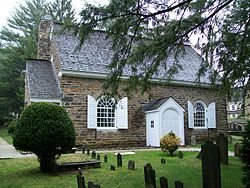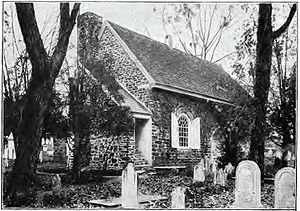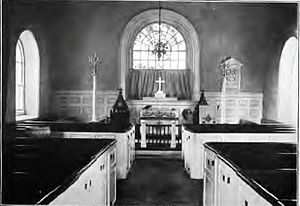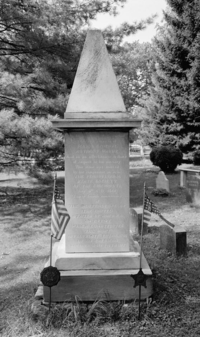- St. David's Episcopal Church (Radnor, Pennsylvania)
-
St. David’s Church and Graveyard
 St. David’s today
St. David’s todayLocation: Wayne, Radnor Township, Pennsylvania Coordinates: 40°1′38″N 75°24′16″W / 40.02722°N 75.40444°WCoordinates: 40°1′38″N 75°24′16″W / 40.02722°N 75.40444°W Built: 1715 Architect: unknown Architectural style: no style listed Governing body: Private NRHP Reference#: 78002394
[1]Added to NRHP: 1978 St. David's Episcopal Church, often known as St. David’s at Radnor or, less often, as Old St. David's, is a parish of the Episcopal Church in the United States of America, founded in the early 18th century and named after the Patron Saint of Wales. A Book of Common Prayer, given as a gift to Lydia Leamy in 1854, refers to St. Davids as "Radnor Church". It has grown to be the largest congregation in the Episcopal Diocese of Pennsylvania, with some 950 active families and 3,000 members.[2] The original church building, built in 1715 and the subject of a Longfellow poem, still stands. It is in nearly the same condition as when it was built, several new buildings having been constructed to house the growing congregation. The adjacent graveyard is a part of the historic site. The church property is divided by the borders of three townships, in two counties, often causing confusion as to the church's location. The church office is located at 763 South Valley Forge Road in Wayne, Radnor Township, Delaware County, Pennsylvania.
Contents
History
Founding
After the establishment of the Welsh Tract in the colony of Pennsylvania, the area was settled by numerous emigrants from Wales, particularly Welsh Quakers, although Welsh people of other faiths, drawn by Pennsylvania’s religious toleration and the opportunity to conduct their affairs in their own language, settled the area as well. In those days, life on the frontier saw exercise of religious beliefs in a limited way (frequently without houses of worship or clergy), which became a concern to many. The Society for the Propagation of the Gospel in Foreign Parts, in London, sent the Welsh Anglican Rev. Evan Evans to the area as a circuit missionary. He began holding fortnightly services in private houses, including that of William Davis in the area known as Radnor, in the southern part of the Welsh Tract starting November, 1700.[3] In 1708, John Oldmixon in his book The British Empire in America noted that
Within land lies Radnor or Welshtown, finely situate and well watered, containing about fifty families; in this place is a congregation of Church of England-Men, but no settled minister[4]When Rev. Evans returned home in 1706, the Welsh-speaking Anglicans of Radnor sent the Society a 100-signature petition requesting a shipment of Welsh-language prayer books and Bibles, and especially requesting another Welsh-speaking missionary. A complete response was apparently slow in coming; ten years later, upon meeting their new leader, the parishioners “heartily engaged themselves to build a handsome stone church to be named after the Patron Saint of Wales”. The cornerstone of the new building was laid on May 9, 1715.[5][6] In an unusual expression of solidarity between denominations, several other clergymen assisted with the laying of the foundation, including Pastor Sandel of Old Swedes Church in Philadelphia.[7] The first worship services took place in the new church on Christmas Eve, 1715.[8] The building still stands, and seats 100 in old-fashioned box pews; the current organ is not original, having been built in 1952.[9]
An early pastor, the Rev. John Clubb, who served from about 1707 to 1715, and later the Rev. Robert Weyman, who served during the 1720s, were paid by the Society for the Propagation of the Gospel in Foreign Parts and shared duties between St. David's and Old Trinity Church, located about 20 miles to the east in Oxford (now part of Philadelphia).[10]
Revolutionary and Federal periods
With the coming of the American Revolution in the colonies, a wave of resentment against the Church of England (which professed loyalty to the king) arose among the congregation. A leader of this opposition was Anthony Wayne, a lifelong member of St. David’s who was later appointed major general of the American forces. The rector, the Rev. William Currie, bound by his oath of duty to the king, resigned his position, which remained officially vacant for 12 years (Rev. Currie performed marriages, baptisms, and the like privately until at least 1783).[11] When the war reached Chester County, the church building provided shelter for soldiers of both sides. While St. David’s left the organization of the Church of England, it remained in the Anglican Communion, and the church was represented at the first General Convention of the Protestant Episcopal Church of the United States in 1784, after the peace treaty was signed.[12]
The church was formally incorporated and chartered in August 1792. A church school was organized in 1820. The first confirmation services were conducted by Bishop William White, who became the first Presiding Bishop. The first physical addition to the church holdings was the fieldstone "Old Rectory" in 1844.[13]
Suburbanization
After the construction of the "main line" of the Pennsylvania Railroad in 1832, the once-isolated community began to evolve more rapidly, particularly after the railroad built local stations and offered frequent train service in the Philadelphia area. One of the way stations on the Main Line was named St. Davids for the church (the station is approximately 3 miles/4km from the church), and a community of the same name grew up around the station. The community has no post office of its own, and is served by the nearby Wayne post office. As Philadelphians began to live outside the city in the late 19th century, the church’s parishioners became more suburban.[14]
As the congregation grew, the parish expanded accordingly. A parish house (office building), with church school facilities, was built in 1924 and enlarged in 1950. Further growth of the congregation led to heated discussion over whether the parish should accommodate a burgeoning membership or retain its early character; this was resolved by the 1956 construction of a new worship building, several times the size of the original church.[15] In a nod to history, the original building retained the name "church" (sometimes called the "old church" for clarity), while the new building was named the "chapel". As a result, the "church" is the small building, while the "chapel" is the larger one, to the unending confusion of visitors.
A separate building was built for Sunday school classes in 1965, the year the parish celebrated its 250th anniversary at a service attended by the Bishop of St David's in Wales. The building is named the Knewstub Building for a former rector of the parish. [16]
Continued growth of the congregation rendered the chapel too small by the time it was 50 years old. A new, larger chapel, seating 650, was constructed adjacent to the old one in 2006. A three-manual, 48-stop, mechanical action organ was installed in 2007.[9] The old chapel, its pews, etc., removed, is now used as the Fellowship Hall, hosting receptions after services and other church-related activities, and serving as a connector between the new chapel and the parish offices.
The church grounds lie at the intersection of three townships and two counties. The old church building, along with a portion of the graveyard, is located in Newtown Township, Delaware County; the chapel and offices (and thus the mailing address) are located in Radnor Township, Delaware County; and most of the graveyard is in Easttown Township, Chester County.[17] All of these townships were originally in Chester County; when Delaware County was divided out of Chester County in 1789, the dividing line was drawn through the St. David’s grounds. This situation can cause problems for the editors and users of databases and directories.
Longfellow poem
In March 1880, the poet Henry Wadsworth Longfellow visited St. David’s. Struck by the peace and quiet of "this little church among its graves", he composed a poem about it: "Old St. David’s at Radnor", which was published later that same year in the collection Ultima Thule. The poem refers to another poet, Welshman George Herbert, and the small Bemerton church of which he was rector.[18]
Historic Structures
The "old" church building, constructed 1715, was added to or modified a number of times, in 1767, 1771, 1786, 1813, 1830, and 1907. These modifications included the relocation of the altar, the addition of an enclosed stair to the choir loft, the addition of a vestry room to the north, and the construction of an enclosure for the main entry door. A horse shed was built in 1850, and added to in 1871.
These structures were recorded in the Historic American Buildings Survey. Numerous photographs were also taken.[19]
Graveyard
The historic graveyard is included with the "old" St. David’s Church on the National Register of Historic Places. Open to all, it also serves as a quiet sanctuary for anyone who wishes to walk its paths or sit amongst the graves and trees.
As might be expected from a churchyard of such an age, there are a number of prominent people buried at St. David’s. These include:
- Anthony Wayne (1745–1796), general in the American Revolution; he died in Erie, Pennsylvania, and was buried there. His son Isaac, wishing to bury him at his home church, traveled to Erie in 1809 and had the body exhumed and rendered to separate the bones from the flesh.[20] All the bones that would fit in Isaac Wayne’s luggage were brought to St. David’s and buried in the Newtown Township portion of the graveyard.
- Isaac Wayne (1772–1852) Anthony Wayne’s son, U.S. Representative from Pennsylvania, 1823–25.
- George W. Pepper (1867–1961), U.S. Senator 1922–1927. He is said to be buried in the Easttown portion of the graveyard.[21]
- William W. Atterbury (1866–1935), Brigadier General in World War I, and President of the Pennsylvania Railroad 1925–1935.
- Helen Hope Montgomery Scott (1904-1995), inspiration of "The Philadelphia Story" and its leading character, Tracy Lord;[22] and her husband, Edgar Scott[23].
- Rose Bampton (1907–2007), opera singer.
- Edward Lowber Stokes (1880–1964), US Congressman.
- R. Norris Williams (1891–1968), professional tennis player and Olympic athlete.
Rectors
The missionaries (to 1714) and rectors (thereafter) of St. David's, with their years of service:[24]
- Evan Evans, D.D., 1700–1704
- John Clubb, ca. 1707– ca. 1712, 1714–1715
- Evan Evans, D.D., 1716–1718
- John Humphreys, 1718–1719
- Robert Weyman, 1719–1730
- Richard Backhouse, 1730–1732
- Griffith Hughes, 1732–1736
- William Currie 1737–1776 (officially), 1776–1785 (unofficially)
- Slator Clay, 1786–1821
- Samuel Crawford Brinckle, 1818–1832
- Simon Wilmer, 1832–1833
- William Henry Rees, D.D., 1833–1838
- Willie Peck, 1838–1845
- Breed Batcheller, 1845–1847
- Thomas Greene Allen, 1847–1848
- John Albemarle Childs, D.D., 1848–1850
- Henry Brown, 1851–1855
- Richardson Graham, 1856–1861
- Thomas Green Clemson, Jr., 1861–1866
- William Frederick Halsey, 1866–1882
- George Alexander Keller, 1882–1902
- James Hart Lamb, D.D., 1902–1918
- William Cunningham Rodgers, D.D., 1919–1922
- Crosswell McBee, D.D., 1922–1945
- John Cecil Knewstub, 1945–1966
- Richard Walton Hess, 1967–1983
- Stephen Kent Jacobson, D.Min., 1984–1996
- W. Frank Allen, 1997–
See also
- Old Trinity Church
- St. Peter's Church in the Great Valley
Notes
- ^ "National Register Information System". National Register of Historic Places. National Park Service. 2008-06-17. http://nrhp.focus.nps.gov/natreg/docs/All_Data.html.
- ^ Art Carey, “For rector, an anthem of dreams: Faithful to Phillies”. The Philadelphia Inquirer, May 13, 2008.
- ^ Pleasants 1907, p. 4
- ^ quoted in Pleasants 1907, p. 3
- ^ Nellie Urner Wallington, Historic Churches of America, Duffield & Company, 1907, p. 74.
- ^ St. David’s Church: Who We Are: History.
- ^ S.F. Hotchkin, Early Clergy of Pennsylvania and Delaware. P.W. Ziegler & Co., Philadelphia, 1890. p. 29.
- ^ St. David’s Episcopal Church, History of St. David’s Church.
- ^ a b St. David’s Church: Worship & Music - Organs & Other Instruments
- ^ Pleasants 1907, pp. 7, 10, 23, 30
- ^ St. David’s Episcopal Church, History of St. David’s Church.
- ^ St. David’s Church: Who We Are: History
- ^ St. David’s Church: Who We Are: History
- ^ St. David’s Church: Who We Are: History
- ^ St. David’s Church: Who We Are: History
- ^ St. David’s Church: Who We Are: History
- ^ "Radnor Township Map" (pdf). Radnor Township, Pennsylvania. http://www.radnor.com/egov/docs/1242070333_222564.pdf. Retrieved April 18, 2009.See coordinate A-4
- ^ St. David; Facts and Legends; Other churches named after him. St. Davids United Church, Calgary, Alberta. Accessed 2010.04.30.
- ^ Library of Congress, Historic American Buildings Survey/Historic American Engineering Record[dead link] (State: Pa; Name: St. David's).
- ^ Hugh T. Harrington and Lisa A. Ennis. "Mad" Anthony Wayne: His Body Did Not Rest in Peace, citing History of Erie County, Pennsylvania, vol. 1. pp. 211–2. Warner, Beers & Co., Chicago. 1884.
- ^ Political Graveyard: Pepper, George Wharton.
- ^ Find a Grave, Helen Hope Montgomery Scott.
- ^ Find a Grave, Edgar Thompson Scott.
- ^ Provided by St. David's June 27, 2008.
Bibliography
- Carey, Art. “For rector, an anthem of dreams: Faithful to Phillies”. The Philadelphia Inquirer, May 13, 2008.
- Harrington, Hugh T., and Lisa A. Ennis. "Mad" Anthony Wayne: His Body Did Not Rest in Peace. http://www.americanrevolution.org/wayne.html.
- Pleasants, Henry; Delaware County Historical Society (1907). History of Old St. David's Church Radnor, Delaware County, Pennsylvania. John C.Winston Co.. pp. 206. http://books.google.com/books?id=KlQVAAAAYAAJ&pg=PA1&dq#v=onepage&q=&f=false.
- History of Erie County, Pennsylvania. Warner, Beers & Co., Chicago. 1884, vol. 1. p. 211–2.
- Hotchkin, S.F. Early Clergy of Pennsylvania and Delaware. P.W. Ziegler & Co., Philadelphia. 1890.
- New York Times, “Two Graves of ‘Mad Anthony’ Wayne: Revolutionary Hero Whose Memory Is Commemorated by New Park Is Officially Buried in Two Places — His Bones Are at Radnor and His Flesh at Erie, Pa.” The New York Times, July 13, 1902, Magazine Section, Page 22.
- Pleasants, Henry. A supplement to the history of old St. David's Church, Radnor, in Delaware County, Pennsylvania,: Containing corrections of errors in original history and important additional data, 1906–1909. John C. Winston Company, 1909.
- Pleasants, Henry. The History of Old St. David's Church Radnor, Delaware County Pennsylvania: With an Appendix Including an Alphabetically Arranged List of Officers, Contributors, &c., And of All Interments in the Burial Ground, with Brief Genealogical Notes....[etc.]. The John C. Winston Company, Philadelphia, 1915.
- St. David’s Episcopal Church. History of St. David’s Church. Unpublished pamphlet.
- Wentzel, Suzanne. “Longfellow to be feted at Bryn Mawr bookstore on his 200th birthday.” Suburban and Wayne Times, Feb. 22, 2007.
- Wallington, Nellie Urner. Historic Churches of America (with introduction by Edward Everett Hale), Duffield & Company, 1907, pp. 73-78. Google Books Original from the New York Public Library, Digitized Feb 28, 2006, 259 pages.
External links
- St. David’s Episcopal Church website
- Longfellow’s poem about St. David’s
- Video of the church and Longfellow’s poem: Henry Wadsworth Longfellow, Old St. David's at Radnor; read by Grover Gardner. Youtube: West Production Services.
- "Mad" Anthony Wayne: His Body Did Not Rest in Peace. Hugh T. Harrington and Lisa A. Ennis.
- Google Street View
- Old Saint David Church Cemetery at Find A Grave
- The St. David's Church (Radnor, Pa.) Records, spanning 300 years, are available for research use at the Historical Society of Pennsylvania.
Categories:- NRHP articles with dead external links
- 20th-century Episcopal church buildings
- Religious buildings completed in 1715
- 1715 establishments in the Thirteen Colonies
- Episcopal churches in Pennsylvania
- Buildings of religious function on the National Register of Historic Places in Pennsylvania
- Cemeteries in Pennsylvania
- Cemeteries on the National Register of Historic Places in Pennsylvania
- Churches in Delaware County, Pennsylvania
Wikimedia Foundation. 2010.






